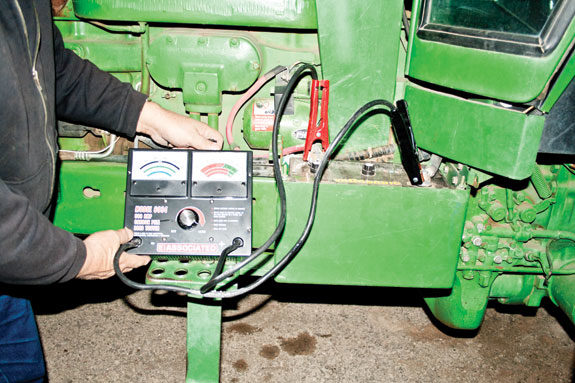In this column, I would like to discuss the testing of batteries, as well as offer some tips to help you troubleshoot and avoid battery problems.
All new batteries have a code stamped on the outside of the case that lets you know the date that it was manufactured and sold.
Locate this code and make a note of it for your records. Make sure the battery is the correct one for your equipment by the application or by cold-cranking amps (CCA).
Testing a battery
After making sure the battery is correct for your piece of equipment or vehicle, the next step is to check the battery by load testing it to determine its condition.
This testing requires the use of a special tool called a battery load tester. A key term to understand when dealing with batteries is cold-cranking amps. If a battery doesn’t have the proper cold-cranking amps, it is not going to do the job for you.
The load tester can load the battery by pulling high amps out of the battery. When batteries are tested, they are tested at one-half of the cold-cranking amps with the load tester.
For example, on a 1000-CCA battery, you would load the battery to 500 amps. The voltage should not drop below 9.5 volts and should hold for approximately 10 seconds.
These specifications change depending on battery size and manufacturer specifications, but this is a very close standard.
The reason cold-cranking amps are important is because it is the amount of current needed to supply the starter with enough energy to crank the engine at a proper speed.
Additional factor
Don’t forget that battery cables and connection are as important as a good battery. Make sure to keep your batteries, including the cables and terminals, clean and the fluid levels up on them.
If you find that the battery, cables and connection are good, the next best step is to test the starter by amp load testing to see if it is working properly.
A very high amp load could mean that the starter is damaged. Have the starter tested or replaced if necessary.
I know, from years of working with equipment that wouldn’t start, that sometimes you hear a click or a series of clicks but no starter response.
This is most likely an indication that you have a low charge on the battery. If the battery is discharged, the proper step to take is to recharge the battery before testing it again.
The cost of a battery charger and a good load tester can be very expensive, ranging anywhere from $1,000 to $1,500. The good news is that most dealers and parts stores can test batteries for you at very little cost.
Other factors that could contribute to the engine not starting include keyswitches, safety switches, starter solenoid switches or even bad wiring.
Jump-starting and jumper cables
Do not jumpstart from the starter (bypass starting) under any condition. Jumpstarting in this manner is very unsafe and can cause deadly injuries.
If you are jumpstarting from the starter while the piece of equipment is still in gear, you run the risk of being run over.
Nowadays, most equipment includes a label attached to the starter to warn operators of the danger of jumpstarting the equipment from the starter.
In fact, many equipment manufacturers eliminate jumpstarting as an option by encasing the starter in a cover.
Jumper cables are not much better because they can be unsafe as well. Batteries can blow up in your face and blind you or someone else because of the hydrogen gas generated in the batteries.
These gases are explosive. There should be no source of ignition near the batteries, whether that is an open flame or even a lit cigarette.
Before you try anything that could be hazardous, get proper training or call a trained mechanic to help you out. Always make sure to use eye protection around batteries.
Wintertime tips
Always keep in mind that cold weather is bad for batteries. At 0° Fahrenheit, the battery is only at 50 percent of its operational capacity.
One of the worst things that can happen during the winter is to have a battery covered on top with dirt or mud because it causes self-discharge.
Self-discharge occurs when electrons in the battery are discharged through the dirt and moisture. You can test if this is happening by checking the voltage on the case of the battery using a voltmeter.
Parking your tractors or any equipment in a covered area (shop or garage) will help keep wind and severe cold from the engine. Also, keep the batteries in your equipment secure, so that they aren’t bouncing all over the place.
In some areas prone to very cold temperatures, battery blankets are used to help warm the batteries to produce more power for starting. Engine block heaters also allow the engine to be warmed prior to starting.
These heaters warm the oil, which in turn warms the engine block and will make it easier for the engine to crank.
A final piece of advice is to always try to buy fresh new batteries if you are replacing old ones. Because batteries are coded for the time of manufacturing, make sure to read these numbers to determine how old the batteries are before purchasing.
Don’t make the mistake of buying a ‘new’ battery that has been sitting on the shelf for a long time.
Also, don’t be mislead by people that just want to make an easy sell and recommend you buy a new battery even when not necessary.
I think most dealers can be trusted, but if you have doubts, get a second opinion from someone else. FG










